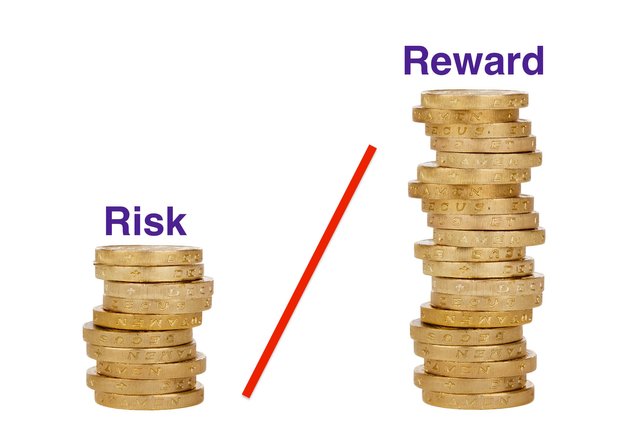Can You Diversify Your Way To Safety?
“Freedom is found not in the taking of risks (it’s far more risky to have a 9-5 job). Freedom is found by removing risks.” - James Altucher
No part of this publication may be reproduced, stored in or introduced into a retrieval system, or transmitted, in any form or by any means (electronically, mechanical, photocopying, recording or otherwise), without the prior written permission from me.
All rights reserved.
Most people I know what money and freedom and safety, but can you really have all three?
Yes.
And no.
The thing is they all have and will come and go in varying amounts throughout our life.
The latter two aside, let’s take a look at money and investing to get more.
Especially if you are here looking for ways to make sure your cryptocurrency investments are safe.
When looking to invest there is something you should know about.
It is called systematic risk.
Systematic risk, also known as nondiversifiable risks, is the inherent risk incurred in investing and cannot be eliminated through portfolio diversification (CTU Portfolio, 2016).
That’s right, you cannot diversify your portfolio enough to overcome the inherent risk involved in giving your money to someone else or placed in some investment vehicle (i.e. any crypto) in hopes of getting more back in return.
The deal is you give the coin, investment, market, etc. the money and you get it back at hopefully 1000% return!
But it is not guaranteed and therefore risky.
Systematic risk can include subcategories such as market risk, foreign currency risks, purchasing power risk, or interest rate risk (CTU Portfolio, 2016).
With the intrinsic risk to investing explained, we can turn our focus to risk involved in individual investments in particular.
In contrast to the systematic risk involved in investing, there are also unsystematic or nonsystematic risks that are unique to a single company, stock or industry (CTU Q&A, 2016).
The main types of unsystematic risk are business risk, default risk, financial risk, and country risk.
These unsystematic risks can be mitigated through research into the various investments prior to making a commitment.
This is when you do your homework.
When attempting to mitigate unsystematic risk there are several options of different types of investments a person can make.
One investment type of investment security is stock which can be common or preferred. Common stock is a security that signifies a portion of ownership in a business and makes the holder eligible for distributions of profits or earning by the company through a dividend payment (CTU Common, 2016).
It is important to note that with common stock, there is no guarantee there will be any distribution or profits or any positive appreciation in the value of the stock or of any return at all on the investment (CTU Common, 2016).
Furthermore, common shareholders have the last claim on any profits or distribution of assets from the firm in the event of liquidation and can only receive distributions after other financial obligations, such as debt owed to creditors, have been met (CTU Common, 2016).
Some of the more typical types of common stock are: Income Stocks, Growth Stocks, and Value Stocks (CTU Types, 2016).
A few lesser known or more specialized common stocks are: Cyclical Stocks, Defensive Stocks, Blue Chips, Penny Stocks, and Speculative Stocks (CTU Types, 2016).
In Crypto you will want to look at things such as current market capitilization, the cryptocurrencies’ total supply (i.e. how many coins are there determines how valuable they can or should be), and inflation.
As Zach Herbert writes in Want to deflate the token bubble? Fix the market cap indicator: “Inflation is the major driver of future market cap. As more tokens are brought into existence, outstanding tokens are diluted. Tokens with healthy inflation rates can often preserve their price per token, but tokens with extremely high levels of inflation should decrease over time.”

Image Source
In “regular investing”, preferred stocks are stocks that are considered a hybrid security because they provide fixed dividend payments, like bonds, but like a stock preferred stock has no maturity date (CTU Preferred, 2016).
Some of the specific types of preferred stock are: Perpetual Preferred, Convertible Preferred, Callable Preferred, Cumulative Preferred, Non-Cumulative Preferred, Participating Preferred, Preference Preferred Shares, Adjustable-Rate (Floating Rate) Preferred (ARPs), Foreign Bank Preferred, and Money Market Preferred Stock (MMPS) (CTU Preferred, 2016).
The advantages of holding preferred stock include quarterly dividend payments, prior claim before common stock in case of liquidation, low cost per share (CTU Preferred, 2016).
These advantages come with a tradeoff of disadvantages such as low yields, interest rate risk and not having voting rights in the company (CTU Preferred, 2016). Other investment options also include bonds, which we will discuss more below, and also index funds, mutual funds, hedge funds.
Again, in “regular investing” there are ways to tell how risky a particular stock is by using something called the “beta coefficient”.
The Beta coefficient is a measurement of the volatility or risk of a stock or portfolio in relation to the market volatility (CTU Q&A, 2016).
“As a point of reference, beta for risk-free assets is zero (0), whereas the beta for the market is one (1)” (CTU Q&A, 2016).
The particular stock’s beta is a reflection how the firm or industry’s unsystematic risk are likely to be impacted by the systematic risks that effect all investments.
Beta is calculated by using regression analysis based on the riskiness of a firm’s stock price in relation to its cash flows.
This covariance of the stock’s price changes in relation to the market versus the variance on the market is used to find the risk of a firm’s stock price or beta.
Looking at a stock’s beta can give investors an indication of how volatile the investment will be compared to other choices in the market.
So in the crypto world Zach Herbert suggests “adding a new metric called inflation factor that indicates how the market cap could be affected over the next five years by token inflation. For example: Inflation factor = (new supply over 5 years) / (current total supply) x 100%.”.

Image Source
A beta applies to a particular stock, but for bonds there are other differences that need to be considered.
Bonds are type debt security where the issuers are borrowers and holders are creditors and they use an instrument called an indenture that is the contract between the issuer and the bondholder that outlines the coupon rate, maturity date, and par value for the bond (Weiss, 2016).
Similar to stocks, there are different types of bonds including: government bonds, such as Treasury bonds and municipal bonds; corporate bonds, issued by companies like stock; and zero-coupon bonds that do not make coupon payment but are issued at a discount to the par value.
To help investors make decisions in the bond market there are two major bond rating companies: Moody’s Investor Service and Standard & Poor’s (Weiss, 2016).
They issue ratings, such as the highest rating AAA, that indicates credit quality, also known as the credit worthiness, or risk of default of the bond (Weiss, 2016).
In cryptocurrncies, you may consider checking out TokenMarket where you can “Trade and research 226 blockchain assets.”
Or if you are really looking for less risk, maybe check out the emergence of Cryptocurrency Index Funds.
At the very least, check out what David Siegel has to say in his Op Ed Crypto-Investing in the Age of Whales.
Either way, whatever you decide to do with your STEEM or other crypto investments, rembember that “Freedom is found by removing risks.” and so do your homework like I did mine.
I think this is a wonderful and interesting time to be alive.
What do you think?
The future together is bright.
Join me.

Check Out Some of My Previous Post:
Hey, before you go, I have a question for you, Are you interested in taking out a loan to consolidate debt?
If you use my Credible Referral link, you can get a cash bonus if you take out a loan.
It can be a Personal Loan or a loan to consolidate Student Loans.
Either way, if you use my link, it can be a "win-win" for us both by saving us money on interest and getting a little bit of money now!
Colorado Technical University. (2016). Common Stock [MUSE]. Retrieved from Colorado Technical University Virtual Campus, FINC605-1601A-01: https://class.ctuonline.edu/CbFileShareCommon/ctu/FINC605/P1/Hub2/21433.pdf
Colorado Technical University. (2016). Portfolio Risk Management Techniques and Ethical
Considerations [MUSE]. Retrieved from Colorado Technical University Virtual Campus, FINC605-1601A-01: https://class.ctuonline.edu/CbFileShareCommon/ctu/FINC605/P1/Hub1/7880.pdf
Colorado Technical University. (2016). Preferred Stock [MUSE]. Retrieved from Colorado Technical University Virtual Campus, FINC605-1601A-01: https://class.ctuonline.edu/_layouts/MUSEViewer/Asset.aspx?MID=2314535&aid=2314 544&pIType=explore_it
Colorado Technical University. (2016). Q&A: Portfolio Risk Management & Ethics [MUSE]. Retrieved from Colorado Technical University Virtual Campus, FINC605-1601A-01: https://class.ctuonline.edu/CbFileShareCommon/coursebuilder/40000/31356.pdf
Colorado Technical University. (2016). Types of Common Stocks [MUSE]. Retrieved from Colorado Technical University Virtual Campus, FINC605-1601A-01: https://class.ctuonline.edu/CbFileShareCommon/coursebuilder/30000/27501.pdf
Weiss, S. (2016). Live Chat Presentation 4: FINC605 _01_284_6_3_0_2, Colorado Springs, CO; CTU Online. Retrieved from Colorado Technical University Virtual Campus, FINC605-1601A-01: https://campus.ctuonline.edu


Yes indeed, systematic risk will essentially always been a risk. You can diversify all you want, if the tide goes down so do all the boats.
Was not aware of TokenMarket, will check it out as I certainly like to do my research.
Thanks, as aways, and yes, there are new research and resources coming online all the time!
A worthy post! Thank you
Thank you!
Your praise is kind and appreciated!